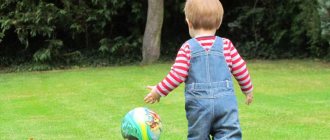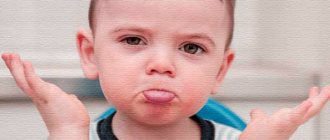By the age of three, most children are already quite independent, they have an idea of the world around them, are armed with some knowledge about objects and their properties, and a child’s speech at 3 years old contains a sufficient number of related words and sentences. After all, they have tested a lot of their knowledge in practice, that is, children have tried out from their own experience how to manipulate objects in their environment, and now they can talk about it with understanding.
A child's speech development at 3 years of age has a particularly wide range for different children of the same age. Some do not experience any difficulties in their statements, are sensitive to the slightest deviation from the norm in the speech of the adults and peers around them, and show interest in the sound analysis of words. At the same time, other children had just begun to construct sentences more or less correctly, and their speech was very far from perfect.
Features of speech development in children 3–4 years old
At this age, children's speech continues to actively develop. Children of the fourth year of life begin to draw conclusions and can reason about objects and the phenomena surrounding them. The child is interested in the world of people and things, he is interested in communicating with loved ones and with strangers. The time has come for questions, the answers to which the child, due to his age, is sometimes not able to listen to the end.
Active and passive dictionary
The development of speech for children 3–4 years old leads to the fact that the number of words that children use in speech (active vocabulary) doubles: from 1 thousand words available to them by the age of three, to 2 thousand by the end of the third year of life . Moreover, they not only use them, but inquisitively listen to the meaning of words, and even create their own. “Who called a cat a cat and a hippopotamus a hippopotamus?” Children play with the word, tasting it, rhyming and changing it, coming up with incredible combinations of sounds: milk, toloko, far, coloko; slam, slam, slam, slam.
Long new words, incomprehensible in content, can be pronounced distorted (lipestricism - electricity, lisipede - bicycle), syllables and sounds are often rearranged in them (pervyi - first, gamazin - shop). Combinations of two consonant sounds in a row continue to cause difficulty in pronunciation. In order to pronounce them correctly, the child inserts a vowel sound between them (zinayu - I know), or simply does not pronounce one consonant sound.
Children can already name the details of objects, distinguish externally similar objects, for example, a cup-mug, a tiger-lion. By the age of three, most children should already be able to easily distinguish the animals in the picture below (show it to your child and check):
When learning new words, children of this age establish semantic connections between objects, actions and their names. They begin to think meaningfully about the vocabulary of their native language. However, children's speech is not yet developed enough for full communication. If at the everyday level the baby still has enough mastered words, then they are not enough to retell a long fairy tale or describe a memorable event.
Speech grammar for three-year-old children
The speech of a four-year-old baby consists of phrases. On average, there are 3-4 words in a sentence. At the age of four, they become common, and complex constructions begin to appear - compound and complex sentences. For example: “the doll wants to eat, I’ll make soup,” “when spring comes, the birds fly.”
Children can use singular and plural homogeneous members in phrases. For example, “I draw flowers and clouds”, “the mouse jumps and laughs”. Nouns and verbs begin to give way to their positions; more and more adjectives, adverbs, pronouns and numerals (one, two, three, first, second, third) are found in speech.
But the speech of a 3-year-old child is still imperfect; it is difficult for him to form the plural of many nouns, for example, trees, mouths, sleeves. In coordinating adjectives with nouns, he can also make mistakes, for example, “ripe apple”, “bright sun”.
Often in the speech of children there are incorrect case endings, and the change of the verb in persons and numbers suffers. For example, “I see trees”, “I have a lot of candy”, “children are riding bicycles”. Show the picture below to your child and check this point:
Sound pronunciation
The child grows - his articulatory apparatus becomes stronger, the movements of the tongue, lips, and lower jaw become more accurate and coordinated. A stronger tongue allows you to correctly pronounce previously softened consonant sounds: malyako - milk, syadik - sadik. Long words of 3–5 syllables, as well as words with combinations of two consonants such as bread, class, bottle, are easier to learn.
Most often at this age the following sound pronunciation disorders occur:
- Replacing hissing sounds with whistling sounds: sapka - cap, nozik - knife;
- Unclearly pronounced sound ts, ch: tsyplenok - chicken, prints - prince, tai-chai;
- Absence in speech of the sounds l, r or their replacement with the sounds y, v, softened l: liba - fish, yodka - boat, vozhka - spoon.
If you notice these disorders in your child, you should not worry, but you should consult with a speech therapist. He will always tell you whether this is the age norm, which does not yet require the intervention of a specialist, or not. Although, we must pay tribute, already at this age there are children whose sound pronunciation has practically no defects.
Speech development at 3 years allows for rearrangements and omissions of syllables in polysyllabic words such as hello, please, purple. Such pronunciation deficiencies are successfully overcome by the end of this age period.
The intonation expressiveness of speech is growing - children can imitate adults, adding very expressive notes to the reading of poems by heart and to stories from their own experience. Adjusting the rate of speech and its volume is not always available to children of the fourth year of life. They may speak very quietly, especially when talking to people they don't know. When the impressions of some significant event are too great, the child can talk about them “excitedly,” hesitating and hastily pronouncing words.
A very valuable quality appears - attention to one’s own speech and to the speech of others. Children begin to notice pronunciation deficiencies made by their peers, but less often - their own.
Connected speech
A three-year-old child is not yet able to logically and coherently talk about what he saw, what interested him, or completely retell the content of a work of art read to him. Children of this age are still unable to deliver a monologue on any topic without additional questions. Children's statements are not developed, the phrases are simple and not always connected with each other.
Children cannot compose a coherent story from a picture. They can only list the objects depicted on it and the actions performed by the characters in the image. “There’s a bunny here. He eats carrots. His mother is there. She sits and watches."
Children of this age easily remember and enjoy reciting poems and nursery rhymes that are understandable in content. They can repeatedly listen to the same fairy tale, and then retell its content almost word for word, and the content of some words may be completely incomprehensible to them (bast hut, tar barrel).
Distinguishing sounds s and c
• Invite your child to repeat pure sayings: “Starlings and tits are cheerful birds,” “The hen laid an egg under the porch.”
• Learn a poem with your child:
The bird wants to wake up
The bird sings a song,
Because a bird with a song
Waking up is more interesting.
V. Berestov
Teaching a child to control speech breathing is an important task. In the fourth year, the child begins to use rather complex sentences consisting of 3-5 or more words, and in order to pronounce them freely and smoothly, one must be able to exhale correctly so that there is enough air for part of the phrase or the entire phrase.
To strengthen and lengthen exhalation, it is necessary to teach the child to expend air correctly. Special games will help you with this. Invite the child to blow on small thin strips of paper or on cotton wool attached to a thread (the cotton wool is held near the child’s mouth, he blows on it and tries to hold it in a deflected position for some time).
To develop speech breathing, invite your child to pronounce several vowel sounds on one exhalation. For example, ask a boy, “How does a little girl cry?” (Uh-huh...) When pronouncing sounds, you need to pay attention to the smooth transition from one sound to another, to the unity of their pronunciation. Pure jokes uttered on one exhale help develop speech breathing:
ha ha ha - they caught a rooster,
co-co-co—we're going far,
tu-tu-tu - give food to the cat.
When practicing correct exhalation, do not forget about inhaling correctly. It should be calm, short, without any particular tension on the muscles of the face and neck.
Games and speech breathing exercises should be carried out systematically, in a well-ventilated room.
It is also necessary to teach the child to control his voice.
You've probably seen how sometimes a child gets on the subway and starts talking to the whole car, asking questions, reading poetry. Some parents rudely pull him back and force him to shut up.
Some children cannot speak quietly when the situation requires it (grandmother is sick, father came home from the night shift, little brother is sleeping, etc.). Others, on the contrary, cannot speak loudly enough, although they have all the data for loud speech. All this indicates that a small child should be taught to use his vocal apparatus and develop the ability to monitor his speech.
First of all, you need to teach him to listen and distinguish the loud speech of others from the quiet one. To do this, say the same phrase with different volumes and ask your child to determine when you said it very loudly, loudly, quietly, or in a whisper.
Use games that will help your child control his own vocal apparatus.
• “Wind and Breeze.” Invite your baby to listen to the howling of a strong wind (pronounce the sound [u] loudly and protractedly: u-u-u...), and then how a small breeze hums (pronounce the sound [u] quietly). Then let him reproduce this sound himself with different volumes (loud, quiet).
If the child speaks quietly, you can use the following technique: talk to him at a certain distance (6-8 steps); in this case, he will inevitably have to speak a little louder.
It is very important that the baby controls the pace of speech. This is important “perhaps, first of all, because,” writes speech therapist V. Lykov, “the tongue twister hurts the ear, irritates, and seems ugly.
But accelerated speech—tachylalia—is not only an aesthetic defect, but also a linguistic one. There is a natural, “normal” rate of speech for our language—10-12 sounds per second. And children sometimes pronounce 20-30 sounds. Naturally, such “fast” speech cannot be clear.
Linguistic haste causes inconvenience not only to the interlocutor, but also to the child himself. His peers begin to laugh at him, use irony, and come up with offensive nicknames.
In a state of excitement, in addition to accelerated speech, children also exhibit other speech disorders: hesitation, rearrangement of syllables, failure to say endings. Tahilalia is reflected in writing and reading: omissions and rearrangements of letters, underwriting of endings, violation of word agreement.
What are the causes of tachylalia? There are several of them - imitation, incorrect methods of speech education, increased nervous excitability, weakness of inhibitory nervous processes. Insufficient speech education in the family is the most common reason for the appearance of rapid speech.
In overcoming tachylalia, the main role belongs to educational techniques: while fighting the child’s fussiness and restlessness, we at the same time “eradicate” haste and confusion of speech. If a child suffers from increased nervous excitability, medication and medical supervision are necessary.
A calm, friendly atmosphere in the family is very important, a firm daily routine is also necessary, calm, measured games (lotto, mosaic, drawing, modeling, design), as well as rhythm and singing, are useful.”
Parents need to remember that often the reason for hasty speech is imitation of the accelerated speech of adults. Therefore, when communicating with a child, you need to monitor your speech and strive to speak at a moderate pace, and when reading or telling a work of fiction, even slightly slower.
If a child speaks quickly, then just reminding him to speak slower will not help him. You need to give a sample of measured speech, for example, read a poem.
Particular attention should be paid to a child with excessively accelerated speech, since fast speech is often a harbinger of stuttering. If a child has difficulty pronouncing words (says t-t-t-ank) or repeats syllables (po-po-po-pohl), then show him to a speech therapist.
A speech delivered on one note is usually inexpressive. The emotionality of speech depends on the correct use of intonation means: raising and lowering the voice, changing the tempo of speech, correct use of pauses, logical stress, etc. A child who hears intonationally expressive speech naturally strives to speak the same way.
Expressive reading of fairy tales and poems by a child helps him use the means of intonation expressiveness in his speech. When reading works of fiction, pay your child’s attention to how certain characters and animals (bear, bunny, fox) speak.
When the child learns to accurately determine by ear how certain characters speak, invite him to reproduce the speech of one or another character, for example, Mikhail Ivanovich, Nastasya Petrovna, Mishutka from L. N. Tolstoy’s fairy tale “The Three Bears.”
By the fourth year of life, the child should generally already be able to use stress. Correctly placed stress in a word ensures clarity and purity of oral speech. It is also one of the means of distinguishing between the words: castle and castle.
In the Russian language (unlike other languages), stress is varied and movable, that is, sounds can be stressed at the beginning, middle and end of a word: perch, machine, needle; the stress can be transferred from one part of the word to another, for example, volka, wolves, but wolves, wolves.
Inaccurate use of stress in words may be the result of imitating the incorrect speech of adults. A child, putting the wrong emphasis on a word, fixes it in his own speech and often pronounces it incorrectly for quite a long time: shop, watermelon, they are calling.
If a child incorrectly uses stress in a word, then parents should correct it and invite the child to repeat it correctly. For example, a child says: “Mom, they’re calling us.” The mother should correct him: “Misha, I must say he’s calling,” and invite the child to repeat the word correctly.
In cases where the child persistently pronounces some words, putting the emphasis on them incorrectly, offer him a game that would require repeating these words. This will help the child avoid mistakes.
“The ability to hear a stressed syllable and highlight it in a word is necessary not only to prepare a child for learning to write and read, but also for the development of oral speech (learning the correct stress).
What exercises can be recommended to parents here? Before directly introducing the child to stress, it is necessary to give the child the idea that a word has a beginning and an end. You can use the following exercise games for this.
• “The end of the word is yours.” “Look at this strip of paper,” says the adult. “It’s as if words are hidden in it.” The words are interesting, different, but they all have the same beginning - say. Let's find out what these words are. We begin to look for: ska... - ... make, - the child prompts. Fine. Listen again: ska...make. We continue to learn other words that also begin. Ska...” The child prompts: ska-kolka, skaz-zka, ska-tert... The adult concludes: “It turns out that there were so many words hidden in this strip, and each word had the same beginning - ska.” Then he asks: “What words can you remember if they begin with li-?” The players suggest: li (sichka), li (da), li (sticks), li (stvennitsa), li (monad)…
After the child has thoroughly learned what the beginning and end of a word are, adults conduct small exercises with him, lasting 2-3 minutes, that allow him to understand that the syllables in a word sound differently, one of them (stressed) can be say longer.
• “Do the parts of the word sound the same?” An adult asks: “Do the parts of the word dad, pa-apa sound the same... What do you hear? That's right, I strengthen my voice when I say the first part of the word. Say the word dad so that this first part is clearly heard.”
Listen to the word fox. I pronounce it like this: “fox-a.” Which part sounds stronger? That's right, part two. Repeat this word with me: fox-a. You can hear very clearly that the second part in the word fox sounds stronger, more noticeable” (G. Tumakova).
Speech development norms for children from 3 to 4 years old
Despite the fact that children of this age period may be at different levels of speech development, there are approximate guidelines that you can rely on when assessing your child’s speech. By the end of three years, the baby comes with the following achievements:
- His speech is clearer and his pronunciation has improved markedly.
- The baby can name almost all the objects around him: clothes, shoes, furniture, toys, interior items.
- More and more adjectives, adverbs, pronouns, and prepositions appear in speech.
- The child matches words by gender, case and number, but not always correctly.
- Children can remember and retell short poems and fairy tales.
Normally developing children of this age strive to communicate with peers and adults and actively establish contacts through speech.
How to determine delayed speech development in 3-year-old children
The development of a child’s speech at 3 years of age is most often accompanied by disturbances in motor skills and behavior. Specialists working with such children can say with full confidence that children with speech impairments exhibit the following signs of activity:
- Children are awkward, their movements are uncoordinated, they have poor balance;
- There is a noticeable lag in fine motor skills of the fingers, precise movements with small parts of toys and board games are inaccessible, children do not like to get dressed, fasten buttons, and cannot regulate the pressure on the pencil while drawing.
- Children are inattentive and constantly distracted;
- Among such children, manifestations of hyperactivity, or, conversely, inhibition are common.
The presence of these symptoms indicates that there are disorders of the central nervous system due to its organic failure. In some cases, delayed speech development (SDD) may be caused by unfavorable conditions for raising a child and his social environment.
Delayed speech development in 3-year-old children affects all aspects of speech: sound pronunciation, vocabulary, coherent speech, and its grammatical design. Possible problems:
- Children do not pronounce not only phrases, but also individual words; their speech remains at the level of babbling.
- There is no coordination of parts of speech; children's speech is similar to the speech of a foreigner who has just learned Russian. For example, “Tanya give me a kitty,” “Kolya went to bed,” “Mom sat down in a chair.”
- Whole groups of sounds are pronounced incorrectly, the child distorts or replaces some sounds with others, rearranges sounds and syllables not only in polysyllabic, but also in simple words. For example, nose - socks, eye - glasses, chamber - lapata.
- Prepositions are missing or used incorrectly (on, in, above, under, behind, before, between).
- The child's speech is unfluent, its pace is too fast or too slow.
- Phrases consist of 1–2, less often 3 words, they contain only nouns and verbs (“telegraphic” style of speech).
At this age, most children are already aware of the limitations of their speech capabilities. Since SRD prevents them from contacting peers and adults, these children may exhibit negativism, isolation, and increased irritability.
Recommendations for parents
Children aged three years old know most objects or their purpose. Therefore, parents need to say the name of unfamiliar objects and explain what they are needed for. In addition, the following exercise is useful for developing vocabulary, grammatical structure and coherent speech: select one subject and describe it. After some time, ask your child about this item. You need to ask questions in such a way that the child gives detailed answers.
Look at books with illustrations together and tell them what is depicted there. You can practice retelling short fairy tales - only they must be accompanied by pictures. During the retelling, ask leading questions that will already contain part of the answer.
After reading a fairy tale, ask for opinions: which hero did you like, why, what was the fairy tale about, what was most memorable. This is a good way to develop grammatical structure and coherent speech.
While walking, look at the surrounding objects, train your counting skills and describe nature (flowers, trees, animals, birds). Answer every question asked, but the sentences should not be difficult for children to understand. An adult’s speech should be understandable, pronounce sounds clearly, and while reading, use intonation to convey the characters’ personalities.
At this age, be sure to play role-playing games. They not only develop imagination, but also improve coherent speech. During such games you can expand your vocabulary. For example, explore new types of clothes, shoes or furniture. Role-playing games are suitable for training diction and expressiveness of speech.
The main task of parents is to encourage children's speech activity and develop social skills. It is at this age that language is not just a tool for understanding the world, but also a way of interacting with people.
Self-diagnosis of speech delay
The main method for diagnosing mental retardation at home is to observe your child’s speech. While observing your baby, you should note how developed his vocabulary is, how many words he uses. For this purpose, play situations are created where children are encouraged to name objects and toys, and small performances are performed with his toys. You need to carefully analyze how the baby constructs phrases and how many words they consist of.
To assess a child’s understanding of adult speech, you can offer him the following tasks:
- Show parts of your body, body parts of toy animals;
- Show in story pictures what their characters are doing. For example, who is running, who is watering the flowers, who is feeding the chickens, who is sleeping;
- Give simple instructions consisting of at least two steps. For example, first take a doll from the closet, and then put it on a chair;
- Ask about the purpose of the items. For example, show what you eat, wipe your hands, brush your teeth;
- Read a short text and ask questions about its content.
It is necessary to note what sounds the baby pronounces incorrectly, what sounds he replaces with those he pronounces. The child’s ability to retell a short fairy tale and his ability to use intonation are assessed. In addition to assessing speech, you need to pay attention to the state of general and fine motor skills. The following indicators are checked:
- Does the child maintain balance when walking and running?
- can he step over objects?
- how he catches the ball
- can he climb?
- does one maintain balance on a reduced area of support while standing on one leg,
- can he fasten buttons?
- Is the baby able to make precise movements with his fingers?
If the development of a child’s speech and motor skills deviates from the norm, you should consult a specialist and undergo the recommended in-depth examination. If there is a need for this, you need to start corrective work with a speech therapist, defectologist, or psychologist.











